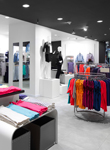By Patty Tartaglia, Senior Lighting Design Specialist, Retailite
Lighting plays a major part in creating the atmosphere for any environment — but it can be crucial within a retail space influencing how your customers shop. Some retailers have reported a 10 per cent increase in sales following a lighting redesign and it makes sense given 80 per cent of the sensory information the brain receives comes from the eyes. Great lighting is not only about how the customer sees a retail display or the retail space but how it makes them feel — with the effects being on a sub conscious level.
Therefore, retailers need to consciously consider the use of light in stores, and each stage of a customer’s journey. For example, there will be great differences in lighting and the mood/reaction they want to create from the storefront to the store’s displays and even the payment area.
From brand perceptions to consumer engagement; lighting creates an emotional connection between your consumer and your business. Once it’s clear lighting simply isn’t about illumination — a consumer’s in-store experience and engagement will thrive.
Here are four ways tailored retail lighting can influence customers:
1. Altered Emotional States
The intensity, direction and distribution of light on?the walls, featured areas, and the general space has?been proven to alter the emotional state of?customers to be more relaxed, tense, and/or to?create feelings of intimacy. It’s vital to consider the?target market for the store when choosing the?lighting. After all, it can encourage them to stay in?the store longer depending on what emotions the?space evokes. For example, the Kathmandu brand?is synonymous with the outdoors, adventure and?experience. The store lighting uses the theatre of lighting design concept to elicit emotion in the customer, create contrast through the store and highlight the active lifestyle and nature of the brand.
2. Direction to Products
The use of directional lighting, and the careful design of lighter and darker areas of the store will influence in-store movement. For example, shoppers will tend to linger longer in areas that have “warm” lighting, and can be utilized to lead customers to desired areas. The University of Hamburg, which studied how people reacted to different retail lighting set ups, found people’s eyes were naturally drawn to areas of contrast, rather than the most brightly lit areas and were attracted to blue light more than any other color. So, it’s wise to strategically place products in specialized lighting to guide customers. Another study by the Royal Institute of Technology in Sweden found shop front windows to be most effective when the lights were shining from the ceiling, rather than the sides. From this they also concluded that a light’s color temperature could be used to lead customers to certain parts of the store or even products. It’s all about the theatre of lighting — control the user’s vision and demand attention, and navigate the attention around the space through the use of lighting.
3. Effects on the Brain
In-store lighting can have an effect on the rhythm of brain activity, which influences how a customer engages with the store. For example, different frequency and intensity combinations of lighting can influence a customer’s perception of a brand — its level of luxury, its competence, and whether the brand’s image is aggressive or placid. Lighting needs to feel part of the creation of the store and reflect the right mood and ambience. It’s important that a lighting design specialist understands the brand’s aesthetic and the visual hierarchy of lighting. Many brands are very specific about the color temperature they use, for example, choosing one that’s a signature of their brand.
For example, this approach was especially important in the fresh produce section at Coles Port Melbourne where bringing out the fruit and vegetables true colors and enhancing their natural beauty was a key consideration. With supermarkets in recent years putting greater emphasis on fresh produce and creating a ‘farmer’s market feel,’ Retailite took this new style of merchandising into careful consideration during the design process.
Specifically, Retailite lit the fresh produce directly from above and used a higher CRI, enhancing their natural colors and textures. In addition, the locations of the lights were redesigned to get a higher light level on the products, improving contrast ratios between the fresh produce and surrounding areas. New targets for lux levels were set (from 700 to 1200) with new beam angle distributions implemented incorporating a dual light layering strategy. This innovative new lighting trial has resulted in a modern look and feel for a fantastic space, as well as drastically improved lux levels on produce.
4. Improving Sales
The ultimate objective for all retailers is to generate sales, and various studies have proven that tailored retail lighting has the potential to change your customer’s purchase size and composition, as well as total spend. For example, a case study involving UK fashion and lifestyle shop Gerry Weber, found a 10 per cent increase in sales following the tailoring of the store lighting to provide a more bright and friendly atmosphere. Improving in-store experience and strengthening the retailer’s brand can increase store traffic and help to increase sales. So, consulting an expert for a tailored retail lighting solution can not only encourage customers to enter the store, but have them feeling a certain way and staying longer to make more purchases. That’s certainly a great return on investment.
For more information, please go to www.retailite.com.au.
